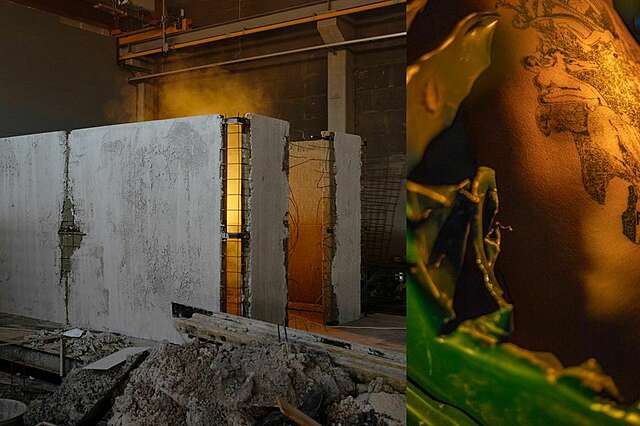The Nordic Pavilion's exhibition sparks a rethinking of architecture

Venla Helenius
Industry Muscle: Five Scores for Architecture explores the modernist built environment through the lens of trans embodiment. Combining architecture, performance, and installation, the exhibition proposes five speculative scores for the architecture of the future.
The Commissioners of the Nordic Countries Pavilion will exhibit an installation and new performance work by the Finnish artist Teo Ala-Ruona and his multidisciplinary team at the 19th International Architecture Exhibition of La Biennale di Venezia.
Curated by Kaisa Karvinen, for Architecture & Design Museum Helsinki, Industry Muscle: Five Scores for Architecture will continue Teo Ala-Ruona’s work on trans embodiment and ecology, expanding his focus into architecture.
The Nordic Pavilion showcases five scores for rethinking architecture
Industry Muscle considers the trans body as a lens through which to examine modern architecture and the built environment, establishing a dialogue with the celebrated architecture of the Nordic Countries Pavilion, designed by Sverre Fehn in 1962. By contrasting Fehn’s canonical work of modernism against an alternative model for architectural practice that takes the trans body as its starting point, the exhibition will offer insights into the relationships between architecture, the body, and ecological collapse.
In Industry Muscle the audience is invited to observe the Nordic Countries Pavilion, as well as architecture more broadly, as a stage for sociopolitical norms that are embedded in fossil-based culture. The staging of the exhibition places the visitor at the centre of an architectural experience where all participants are on display, enacting everyday performances. In Ala-Ruona’s interventions, the trans body crowbars its way into this structure and reveals the blueprint within.
Industry Muscle unfolds through five speculative scores that serve as critical prompts for future architecture. Scores are used in performance art as tasks, notations, and exercises that provide instructions for a performer.
Teo Ala-Ruona works at the intersection between performance art, theatre and choreography, and focuses on trans embodiment and ecology. For Industry Muscle, he has assembled a multidisciplinary team of collaborators including architect A.L. Hu, set designer and artist Teo Paaer, sound designer Tuukka Haapakorpi, dramaturge Even Minn, visual artist Venla Helenius, fashion designer Ervin Latimer, graphic designer Kiia Beilinson and performers Kid Kokko, Caroline Suinner, and Romeo Roxman Gatt. Collaboration plays a central role in Ala-Ruona’s work. Each member of the working group contributes their own artistic part to the exhibition.
“Sverre Fehn’s Nordic Countries Pavilion is a canonical work of modernist architecture that provides an engaging setting for Teo Ala-Ruona, a performance artist whose practice explores trans embodiment, the material environment, and ecological questions. Incorporating Ala-Ruona and his team into the context of architectural exhibitions opens up new perspectives on architectural discourse, particularly concerning the built environment, the body, and fossil fuel culture”, says Kaisa Karvinen, Curator of the Nordic Countries Pavilion on behalf of Architecture & Design Museum Helsinki.
“In Ala-Ruona’s work, the performance works as a research tool. In the field of performance art, experience of embodiment is studied and valued in a way that has much to offer architectural discourse. After all, the human body has always been one of the fundamental starting points for spatial design and architecture”, she continues.
Teo Ala-Ruona says:
“Industry Muscle will speculate on an alternative model for architectural practice, grounded in the experience of the trans body. Conceptually, this can be as simple but as fundamental as the sensation of comfort that comes when I am in a visually complex space that places less emphasis on the silhouette of my body, a reversal of the modernist ideal expressed in the architecture of the pavilion.”
“The built environment is largely constructed based on prevalent cultural norms. This plays a crucial role in the staging of bodies in everyday life, and in creating the ecological burden of the building industry. With my team of multidisciplinary collaborators, I want to start new conversations by exploring the possibilities of an architectural practice that contrasts sharply with the status quo.”
The Biennale Architettura 2025 will open to the public on 10 May and remain open until 23 November. The opening of the exhibition at the Nordic Pavilion will take place on Thursday 8 May, same day as the opening of the exhibition at the Pavilion of Finland.
The Nordic Countries Pavilion is commissioned by an alliance formed of Architecture & Design Museum Helsinki (Finland), The National Museum of Norway and ArkDes (Sweden). The three commissioning bodies rotate the leadership of the commissioning process, which for the 19th International Architecture Exhibition has been led by Architecture & Design Museum Helsinki.
This year, Finland is exceptionally widely represented at the Biennale Architettura, with the exhibition The Pavilion – Architecture of Stewardship at the Finnish National Pavilion and the exhibition at the Nordic Pavilion, in addition to three Finnish teams participating in the Biennale's main exhibition. Read more about Finland's super year at the biennale through this link.


